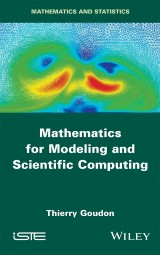Details

Mathematics for Modeling and Scientific Computing
1. Aufl.
|
139,99 € |
|
| Verlag: | Wiley |
| Format: | |
| Veröffentl.: | 14.10.2016 |
| ISBN/EAN: | 9781119371182 |
| Sprache: | englisch |
| Anzahl Seiten: | 472 |
DRM-geschütztes eBook, Sie benötigen z.B. Adobe Digital Editions und eine Adobe ID zum Lesen.
Beschreibungen
<p>This book provides the mathematical basis for investigating numerically equations from physics, life sciences or engineering. Tools for analysis and algorithms are confronted to a large set of relevant examples that show the difficulties and the limitations of the most naïve approaches. These examples not only provide the opportunity to put into practice mathematical statements, but modeling issues are also addressed in detail, through the mathematical perspective.</p>
<p>Preface ix</p> <p><b>Chapter 1. Ordinary Differential Equations 1</b></p> <p>1.1. Introduction to the theory of ordinary differential equations 1</p> <p>1.1.1. Existence–uniqueness of first-order ordinary differential equations 1</p> <p>1.1.2. The concept of maximal solution 11</p> <p>1.1.3. Linear systems with constant coefficients 16</p> <p>1.1.4. Higher-order differential equations 20</p> <p>1.1.5. Inverse function theorem and implicit function theorem 21</p> <p>1.2. Numerical simulation of ordinary differential equations, Euler schemes, notions of convergence, consistence and stability 27</p> <p>1.2.1. Introduction 27</p> <p>1.2.2. Fundamental notions for the analysis of numerical ODE methods 29</p> <p>1.2.3. Analysis of explicit and implicit Euler schemes 33</p> <p>1.2.4. Higher-order schemes 50</p> <p>1.2.5. Leslie’s equation (Perron–Frobenius theorem, power method) 51</p> <p>1.2.6. Modeling red blood cell agglomeration 78</p> <p>1.2.7. SEI model 87</p> <p>1.2.8. A chemotaxis problem 93</p> <p>1.3. Hamiltonian problems 102</p> <p>1.3.1. The pendulum problem 106</p> <p>1.3.2. Symplectic matrices; symplectic schemes 112</p> <p>1.3.3. Kepler problem 125</p> <p>1.3.4. Numerical results 129</p> <p><b>Chapter 2. Numerical Simulation of Stationary Partial Differential Equations: Elliptic Problems 141</b></p> <p>2.1. Introduction 141</p> <p>2.1.1. The 1D model problem; elements of modeling and analysis 144</p> <p>2.1.2. A radiative transfer problem 155</p> <p>2.1.3. Analysis elements for multidimensional problems 163</p> <p>2.2. Finite difference approximations to elliptic equations 166</p> <p>2.2.1. Finite difference discretization principles 166</p> <p>2.2.2. Analysis of the discrete problem 173</p> <p>2.3. Finite volume approximation of elliptic equations 180</p> <p>2.3.1. Discretization principles for finite volumes 180</p> <p>2.3.2. Discontinuous coefficients 187</p> <p>2.3.3. Multidimensional problems 189</p> <p>2.4. Finite element approximations of elliptic equations 191</p> <p>2.4.1. P1 approximation in one dimension 191</p> <p>2.4.2. P2 approximations in one dimension 197</p> <p>2.4.3. Finite element methods, extension to higher dimensions 200</p> <p>2.5. Numerical comparison of FD, FV and FE methods 204</p> <p>2.6. Spectral methods 205</p> <p>2.7. Poisson–Boltzmann equation; minimization of a convex function, gradient descent algorithm 217</p> <p>2.8. Neumann conditions: the optimization perspective 224</p> <p>2.9. Charge distribution on a cord 228</p> <p>2.10. Stokes problem 235</p> <p><b>Chapter 3. Numerical Simulations of Partial Differential Equations: Time-dependent Problems 267</b></p> <p>3.1. Diffusion equations 267</p> <p>3.1.1. L2 stability (von Neumann analysis) and L∞ stability: convergence 269</p> <p>3.1.2. Implicit schemes 276</p> <p>3.1.3. Finite element discretization 281</p> <p>3.1.4. Numerical illustrations 283</p> <p>3.2. From transport equations towards conservation laws 291</p> <p>3.2.1. Introduction 291</p> <p>3.2.2. Transport equation: method of characteristics 295</p> <p>3.2.3. Upwinding principles: upwind scheme 299</p> <p>3.2.4. Linear transport at constant speed; analysis of FD and FV schemes 301</p> <p>3.2.5. Two-dimensional simulations 326</p> <p>3.2.6. The dynamics of prion proliferation 329</p> <p>3.3. Wave equation 345</p> <p>3.4. Nonlinear problems: conservation laws 354</p> <p>3.4.1. Scalar conservation laws 354</p> <p>3.4.2. Systems of conservation laws 387</p> <p>3.4.3. Kinetic schemes 393</p> <p>Appendices 407</p> <p>Appendix 1 409</p> <p>Appendix 2 417</p> <p>Appendix 3 427</p> <p>Appendix 4 433</p> <p>Appendix 5 443</p> <p>Bibliography 447</p> <p>Index 455</p>
<p><strong>Thierry GOUDON</strong>, Senior research scientist INRIA, Sophia Antipolis Mediterranee Research Centre & Labo. J. A. Dieudonne, University of Nice Sophia Antipolis & CNRS, France

















